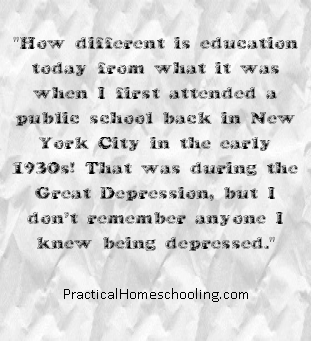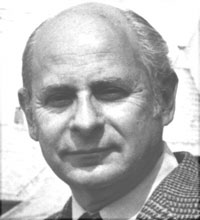Going to School Back in the Great Depression
By Sam Blumenfeld
Printed in Practical Homeschooling #90, 2009.
 Sam contrasts schools where he grew up in depression-era New York to modern schools.
Sam contrasts schools where he grew up in depression-era New York to modern schools.

| 
|
One of the great advantages of being 83 years old is that I have lived
through a great deal of history and have a perspective on life that you,
my younger readers, do not have. I remember the days when I would look
around and find myself perhaps the youngest person in the crowd. I took
great delight in that. Today I look around and I am usually the oldest.
But I know that God has kept me around for a purpose, and I suspect that
He wants me to keep doing what I have been doing for the last forty
years: writing about education and promoting homeschooling.
 How different is education today from what it was when I first attended
a public school back in New York City in the early 1930s! That was
during the Great Depression, but I don’t remember anyone I knew being
depressed. My father was in the produce business and thus we always had
plenty of food to eat. My mother actually made her own noodles for
chicken soup. I was able to walk to school and come home for lunch. I
remember admiring the smiling policeman who stopped traffic so that we
could cross the avenue on our way to school.
How different is education today from what it was when I first attended
a public school back in New York City in the early 1930s! That was
during the Great Depression, but I don’t remember anyone I knew being
depressed. My father was in the produce business and thus we always had
plenty of food to eat. My mother actually made her own noodles for
chicken soup. I was able to walk to school and come home for lunch. I
remember admiring the smiling policeman who stopped traffic so that we
could cross the avenue on our way to school.
On Saturdays my friends and I went to the movies. Price of admission?
Ten cents. In those days a penny could get you a Tootsie Roll, a package
of gum, or a bun. Five cents could get you a hotdog.
At school we all sat in desks bolted to the floor. The desks were
arranged in rows so that you only saw the back of the head of the pupil
in front of you. If you coughed, you didn’t cough in anyone’s face.
Today, with kids seated around tables, they are coughing into each
other’s faces and spreading disease.
Back then, the teacher had her desk at the front of the class and she
taught us all the same thing. There was no such thing as an “individual
learning plan.” We learned to read with phonics because it was the
Depression and the schools could not afford the new Dick-and-Jane
look-say books. We were taught penmanship—cursive writing—which helped
us learn to read because it taught us directionality and manual
discipline. By connecting the letters in a word, we learned the word’s
spelling and how different combinations of letters made different
sounds.
Back then in elementary school we were taught arithmetic, not math.
Arithmetic is a counting system. In addition you count forward. In
subtraction you count backwards. In multiplication you count forward in
multiples, and in division you count backwards in multiples. The
teachers knew then that only by memorizing the arithmetic facts could
you become efficient at using this ingenious place-value counting
system. And so we memorized the arithmetic tables. Mathematics, which
dealt with relationships, came later.
Of course, some of us learned the 3Rs better than others. Some of our
teachers were not terribly good at teaching. Others were great, and we
loved them. I remember being humiliated in front of a class because, for
some reason, I could not remember some simple arithmetic function, and
that angered the teacher.
From that experience, I have always advised tutors and homeschooling
parents to never get angry when a child is having difficulty learning
something. Be patient, and explain what it is that you want the student
to learn. The brain is a very remarkable instrument and can do both
amazing and silly things—often at the same time!
So we all learned reading, writing, and arithmetic. And because we could
read, we then learned history and geography. We learned all about the
history of New York and its five boroughs. It was a happy time for us
kids. No one had dyslexia, or ADD, or ADHD. No one was on Ritalin. There
was no sex ed or death ed, no multiculturalism, no values clarification,
no secular humanism. The schools did not try to undermine our religious
beliefs or morals. They were teaching us to become good patriotic
Americans. Since most of us came from immigrant families, becoming good
Americans was very important. The only decoration in our classroom was a
portrait of George Washington. Moreover, Biblical religion was
respected, and the Principal recited the 23rd Psalm at each assembly.
In third grade, we had Music Appreciation. The teacher brought out her
hand-driven Victrola from the closet and played classical music for us.
I still remember some of the pieces she played: “The Swan” by
Saint-Saens, “March Slav” by Tchaikovsky. I know that that’s where I
acquired my taste for classical music.
So I had a very decent primary and elementary education. The public
school was an institution which instilled great patriotic values and
love of country. They did not dumb us down; they lifted us up. But those
days are long gone, and today I tell parents: do not put your child in a
public school. If you want to preserve their mental sanity, teach them
at home.
Today’s public schools have become criminal enterprises where children’s
brains are deliberately crippled by whole-language and look-say, where
drugs are pushed on millions of children who must ingest Ritalin, where
a child’s religious beliefs are undermined by the practices of
behavioral psychology, where pornography is foisted on the students in
the name of sex education, where money is extorted from taxpayers to pay
for the dumbing down of the future generation. Children in such a system
will suffer lifelong deficits. That is why homeschooling is so
important, and why homeschooled students should bless their parents for
keeping them out of such a harmful system.
Education expert Sam Blumenfeld’s Alpha-Phonics reading program is
available on www.samblumenfeld.net. His latest book, The
Marlowe-Shakespeare Connection, is about the Shakespeare authorship
mystery.